
Nick Coulson with his still life work.
Working from his home studio in inner-city Brisbane, Nick Coulson recalls his first art class in high school having an immediate impact: “The teacher explained the task, asked if we had any questions then turned the radio on and let us create,” he says. “I remember thinking to myself, ‘Hang on, this is pretty good!’”
While the concept of art as a profession was something Nick fleetingly considered, he didn’t see it as realistic at the time. Opting to study commerce allowed him to live and work in Brisbane, Lisbon, Hong Kong and London, with galleries, exhibitions and architecture becoming an integral aspect of his stay in each city.
“In London, my work was walking distance to the National Gallery, National Portrait Gallery and the British Museum, among others,” he explains. “These are the places my lunch breaks were spent.”
During this time in London, Nick and his wife Ruth started their family, and he made the decision to resign from his job and take up the role of stay-at-home Dad. “We now have three young men,” he adds. “As our sons became more independent, Ruth suggested I get back into painting and, since 2015, this has been my focus.”
Here Nick talks about influential exhibitions, the key lesson learned from entering art prizes, his relaxed approach to social media and why often overlooked domestic objects take pride of place in his still life work.
Interview by Lisa Doust
Is painting your full-time profession?
I wear a few hats – painting occupies most of my week and I’m also a tennis coach.
Who or what were your early influences?
When I think of early influences, I think of two exhibitions that came to the Queensland Art Gallery when I was at school that resonated, and continue to resonate, with me. The first was Pop Art 1955-70, and then 20th Century Masters. With Pop Art, the palette and mediums used gave me a ‘way-in’ to creating, and over time this has tended towards traditional painting. I refer often to both exhibition catalogues.
When did you sell your first artwork and where do you currently sell your work?
I sold my first work in 2015, at an end-of-semester student exhibition in Brisbane. Since then, I’ve been involved with successful self-organised group exhibitions. I am also fortunate to have had recent works exhibited with Michael Reid Northern Beaches in Sydney and I have a continued exhibiting relationship with Lethbridge Gallery in Brisbane.
You are only as good as your next painting, so one needs to keep creating works of quality to foster these exhibition opportunities.
How did you arrive at painting everyday objects?
It wasn’t a regimented decision process. I simply gravitate to certain things and always have. I tend to like painting simple objects of utility and urban landscapes.
I have a diverse range of interests, however taps, coffee cups and bottles, things I consider to be everyday objects, tend to be recurring themes. I also enjoy music, which weaves its way into my work.
What are you most inspired by at present?
Inspiration comes from a wide range of sources – record covers, magazines, fashion, song lyrics, items in our kitchen cupboard, urban scenes from accumulated travel. I am constantly taking photos of compositions and colours that appeal.
I continue to enjoy visiting the studios of local Brisbane artists, bouncing things off them and hearing them speak about their practice. Their counsel is invaluable.
How do you promote your work, and how much help do you receive from the galleries you sell via?
I post sporadically on Instagram. I am very content to be linked to galleries that have a greater reach and more marketing experience than I do.
Do you outsource any aspects of running your art business?
I outsource my picture framing and, over the years, have created a rapport with my framer that I value.
What do you find are the biggest challenges of being an artist?
Painting is mostly of a subjective nature. The challenge is to stick to your guns and be confident of your own individual output. If it’s authentic and sustainable over an extended period of years, an audience will accumulate.
Do you network with other artists? If so, what are the benefits?
The social connection to painting is very important to me. There are similar threads that run through all artists’ decision-making processes, regardless of career stage. Constructive feedback from others can improve your paintings and I feel the social connection becomes more important rather than less.
What is the best advice you have received?
I like this quote by Georges Braque: One’s style is one’s inability to do otherwise.
You have been a finalist in several art prizes – what inspires you to enter and have you found that being a finalist has increased your profile?
Art prizes in my earliest years were good for a few reasons, and being a finalist in certain prizes can assist in building your profile. The resilience required to believe in the worth of a painting, regardless of whether it’s selected (or purchased) as a finalist, was probably an important lesson for me.
How is your year ending and what will you be focusing on in 2024?
I am currently part of the Christmas Exhibition at Lethbridge Gallery and consider myself very fortunate to be recently included in the ACB Selects 2023 online exhibition, selected by Amber Creswell Bell, Director of Emerging Art for Michael Reid galleries.
